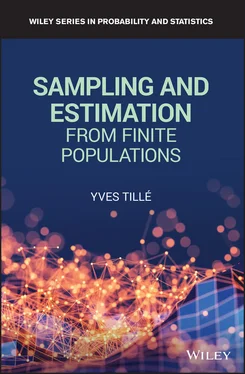Yves Tille - Sampling and Estimation from Finite Populations
Здесь есть возможность читать онлайн «Yves Tille - Sampling and Estimation from Finite Populations» — ознакомительный отрывок электронной книги совершенно бесплатно, а после прочтения отрывка купить полную версию. В некоторых случаях можно слушать аудио, скачать через торрент в формате fb2 и присутствует краткое содержание. Жанр: unrecognised, на английском языке. Описание произведения, (предисловие) а так же отзывы посетителей доступны на портале библиотеки ЛибКат.
- Название:Sampling and Estimation from Finite Populations
- Автор:
- Жанр:
- Год:неизвестен
- ISBN:нет данных
- Рейтинг книги:4 / 5. Голосов: 1
-
Избранное:Добавить в избранное
- Отзывы:
-
Ваша оценка:
Sampling and Estimation from Finite Populations: краткое содержание, описание и аннотация
Предлагаем к чтению аннотацию, описание, краткое содержание или предисловие (зависит от того, что написал сам автор книги «Sampling and Estimation from Finite Populations»). Если вы не нашли необходимую информацию о книге — напишите в комментариях, мы постараемся отыскать её.
Sampling and Estimation from Finite Populations Provides an up-to-date review of the theory of sampling Discusses the foundation of inference in survey sampling, in particular, the model-based and design-based frameworks Reviews the problems of application of the theory into practice Also deals with the treatment of non sampling errors
is an excellent book for methodologists and researchers in survey agencies and advanced undergraduate and graduate students in social science, statistics, and survey courses.

 is selected in sample
is selected in sample  .Figure 7.4 The sample
.Figure 7.4 The sample  is the intersection of samples
is the intersection of samples  and
and  .
. grid, a systematic sample and a stratified sample with one u...Figure 8.2 Recursive quadrant function used for the GRTS method with three sub...Figure 8.3 Original function with four random permutations.Figure 8.4 Samples of 64 points in a grid of
grid, a systematic sample and a stratified sample with one u...Figure 8.2 Recursive quadrant function used for the GRTS method with three sub...Figure 8.3 Original function with four random permutations.Figure 8.4 Samples of 64 points in a grid of  points using simple designs, GR...Figure 8.5 Sample of 64 points in a grid of
points using simple designs, GR...Figure 8.5 Sample of 64 points in a grid of  points and Voronoï polygons. App...Figure 8.6 Interval corresponding to the first wave (extract from Qualité, 20...Figure 8.7 Positive coordination when
points and Voronoï polygons. App...Figure 8.6 Interval corresponding to the first wave (extract from Qualité, 20...Figure 8.7 Positive coordination when  (extract from Qualité, 2009).Figure 8.8 Positive coordination when
(extract from Qualité, 2009).Figure 8.8 Positive coordination when  (extract from Qualité, 2009).Figure 8.9 Negative coordination when
(extract from Qualité, 2009).Figure 8.9 Negative coordination when  (extract from Qualité, 2009).Figure 8.10 Negative coordination when
(extract from Qualité, 2009).Figure 8.10 Negative coordination when  (extract from Qualité, 2009).Figure 8.11 Coordination of a third sample (extract from Qualité, 2009).Figure 8.12 Two survey frames
(extract from Qualité, 2009).Figure 8.11 Coordination of a third sample (extract from Qualité, 2009).Figure 8.12 Two survey frames  and
and  cover the population. In each one, we se...Figure 8.13 In this example, the points represent contaminated trees. During t...Figure 8.14 Example of indirect sampling. In population
cover the population. In each one, we se...Figure 8.13 In this example, the points represent contaminated trees. During t...Figure 8.14 Example of indirect sampling. In population  the units surrounded...
the units surrounded... with
with  and
and  .Figure 12.2 Linear method: function
.Figure 12.2 Linear method: function  with
with  and
and  Figure 12.3 Linear method: function
Figure 12.3 Linear method: function  with
with  .Figure 12.4 Raking ratio: pseudo‐distance
.Figure 12.4 Raking ratio: pseudo‐distance  with
with  and
and  .Figure 12.5 Raking ratio: function
.Figure 12.5 Raking ratio: function  with
with  and
and  .Figure 12.6 Raking ratio: function
.Figure 12.6 Raking ratio: function  with
with  .Figure 12.7 Reverse information: pseudo‐distance
.Figure 12.7 Reverse information: pseudo‐distance  with
with  and
and  .Figure 12.8 Reverse information: function
.Figure 12.8 Reverse information: function  with
with  and
and  .Figure 12.9 Reverse information: function
.Figure 12.9 Reverse information: function  with
with  .Figure 12.10 Truncated linear method: pseudo‐distance
.Figure 12.10 Truncated linear method: pseudo‐distance  with
with 

 , and
, and  .Figure 12.11 Truncated linear method: function
.Figure 12.11 Truncated linear method: function  with
with 

 , and
, and  .Figure 12.12 Truncated linear method: calibration function
.Figure 12.12 Truncated linear method: calibration function  with
with 

 , and
, and  Figure 12.13 Pseudo‐distances
Figure 12.13 Pseudo‐distances  with
with  and
and  .Figure 12.14 Calibration functions
.Figure 12.14 Calibration functions  with
with  and
and  .Figure 12.15 Logistic method: pseudo‐distance
.Figure 12.15 Logistic method: pseudo‐distance  with
with 

 , and
, and  .Figure 12.16 Logistic method: function
.Figure 12.16 Logistic method: function  with
with 

 , and
, and  .Figure 12.17 Logistic method: calibration function
.Figure 12.17 Logistic method: calibration function  with
with 
 and
and  .Figure 12.18 Deville calibration: pseudo‐distance
.Figure 12.18 Deville calibration: pseudo‐distance  with
with 
 Figure 12.19 Deville calibration: calibration function
Figure 12.19 Deville calibration: calibration function  with
with  .Figure 12.20 Pseudo‐distances
.Figure 12.20 Pseudo‐distances  of Roy and Vanheuverzwyn with
of Roy and Vanheuverzwyn with  ,
,  , and
, and  .Figure 12.21 Calibration function
.Figure 12.21 Calibration function  of Roy and Vanheuverzwyn with
of Roy and Vanheuverzwyn with  and
and  .Figure 12.22 Variation of the
.Figure 12.22 Variation of the  ‐weights for different calibration methods as a...
‐weights for different calibration methods as a...










